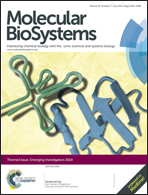Exploration of the antagonist CP-376395 escape pathway for the corticotropin-releasing factor receptor 1 by random acceleration molecular dynamics simulations†
Abstract
Corticotropin-releasing factor receptor 1 (CRF1R), a member of class B G-protein-coupled receptors (GPCRs), plays an important role in the treatment of osteoporosis, diabetes, depression, migraine and anxiety. To explore the escape pathway of the antagonist CP-376395 in the binding pocket of CRF1R, molecular dynamics (MD) simulations, dynamical network analysis, random acceleration molecular dynamics (RAMD) simulations and adaptive biasing force (ABF) calculations were performed on the crystal structure of CRF1R in complex with CP-376395. The results of dynamical network analysis show that TM7 of CRF1R has the strongest edges during MD simulation. The bent part of TM7 forms a V-shape pocket with Gly3567.50. Asn2835.50 has high hydrogen bond occupancy during 100 ns MD simulations and is the key interaction residue with the antagonist in the binding pocket of CRF1R. RAMD simulation has identified three possible pathways (PW1, PW2 and PW3) for CP-376395 to escape from the binding pocket of CRF1R. The PW3 pathway was proved to be the most likely escape pathway for CP-376395. The free energy along the PW3 pathway was calculated by using ABF simulations. Two energy barriers were found along the reaction coordinates. Residues Leu3236.49, Asn2835.50 and Met2063.47 contribute to the steric hindrance for the first energy barrier. Residues His1993.40 and Gln3557.49 contribute to the second energy barrier through the hydrogen bonding interaction between CP-376395 and CRF1R. The results of our study can not only provide useful information to understand the interaction mechanism between CP-376395 and CRF1R, but also provide the details about the possible escape pathway and the free energy profile of CP-376395 in the pocket of CRF1R.


 Please wait while we load your content...
Please wait while we load your content...